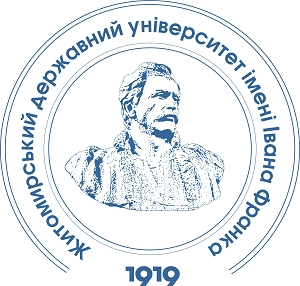INFLUENCE OF THE LEVEL OF MOISTURE SUPPLY AND FEEDING AREA ON THE STRUCTURE OF SOYBEAN YIELD AND THEIR IMPORTANCE FOR SEED PRODUCTION
DOI:
https://doi.org/10.32782/naturaljournal.12.2025.21Keywords:
soybeans, varieties, seed production, crop structure, weight of 1 000 seeds, feeding area, weather conditionsAbstract
Realising the productivity potential of each variety is a process that is directly related to its adaptive characteristics, such as plasticity and stability. These important properties include indicators such as yield, thousand-seed weight and seed fraction composition, crop structural elements and seed quality.Varieties that demonstrate low adaptability or reduced plasticity are usually subject to significant fluctuations in the above-mentioned parameters from year to year. At the current stage of technology development in agriculture, especially in soybean cultivation, the importance of the variety and its varietal technology is becoming increasingly important, especially in the field of seed production. This is due to the need to optimise agronomic approaches to achieve maxi mum efficiency and sustainability of production processes. The article presents the results of research on the influence of moisture supply and nutrition area on the yield structure of soybean varieties and their importance for seed production in the arid conditions of the Forest-Steppe of Ukraine.The field studies were conducted in 2022–2024 on the territory of the farm ‘Gryga’ (according to the contract), located in Poltava district of Poltava region. The soil in the area is characterised as typical black soil with low humus content, and the previous crop was winter wheat. The study evaluated 12 soybean varieties developed by leading Ukrainian breeding institutions. These include Avanturin, Adamos, Almaz, Alexandrite, Anthracite, Aquamarine, Arnika, Golubka, Zlatoslava, Muza, Siverka and Samorodok. Laboratory and field experiments have shown significant variability in the response of varieties to changes in the area of nutrition and moisture supply. In addition, the research revealed variations in a number of parameters: plant height, lower bean height, number of beans, number of seeds per plant, number of nodes on the main stem, branching and productivity of each individual variety. The analysis of a wide range of soybean varieties and the impact of feeding area on their productivity was carried out using model experiments. Thanks to the structural analysis of soybean plants, a number of indicators were perfectly evaluated.
References
Білявська Л.Г., Рибальченко А.М. Мінливість господарсько цінних ознак сої в умовах Лівобережного Лісостепу України. Вісник Полтавської державної аграрної академії. 2019. № 1. С. 65–72. https://doi.org/10.31210/visnyk2019.01.08.
Білявська Л.Г., Пилипенко О.В. Поради щодо вибору сорту сої для виробника. Агроексперт. 2016. № 3. С. 26–27 [Електронний ресурс]. URL: https://agroexpert.ua/poradi-sodo-viboru-sortu-soi-dla-virobnika/ (дата звернення: 27.01.2025).
Пилипенко О.В., Брижак Я.В., Білявська Л.Г., Білявський Ю.В. Напрями та досягнення в насінництві сої. Урожайність та якість продукції рослинництва за сучасних технологій вирощування (присвячено пам’яті професора Г.П. Жемели) : матеріали Всеукраїнської науково-практичної інтернет-конференції. ПДАУ. 2022. С. 124–127.
Ревтьо О.Я., Золін О.О. Особливості вирощування сої за умов зміни клімату (оглядова). Таврійський науковий вісник. 2023. № 133. С. 105–112. https://doi.org/10.32782/2226-0099.2023.133.15.
Рябуха С.С., Чернишенко П.В., Святченко С.І., Садовой О.О., Тесля Т.О. Вплив гідротермічних чинників довкілля на врожайність та біохімічний склад насіння сої. Селекція і насінництво. 2019. № 115. С. 93–102. https://doi.org/10.30835/2413-7510.2019.172785.
Соя (Glycine max (L.) Merr.) : монографія / В.В. Кириченко та ін. Харків : НААН, Інститут рослинництва ім. В.Я. Юр’єва, 2016. 400 с.
Соя: модель сорту, новостворені неопушені лінії, насінництво, фітосанітарний стан посівів : колективна монографія / pа ред. Л.Г. Білявської. Полтава : ПДАУ, 2023. 187 с.
Ходаніцька O.O., Погоріла Л.Г., Шевчук О.А., Ткачук O.O., Матвійчук О.А. Врожайність та якість насіння сої в умовах Правобережного Лісостепу України. Корми і кормовиробництво. 2024. № 98. С. 120–128. https://doi.org/10.31073/kormovyrobnytstvo202498-11.
Цицюра Т.В., Темченко І.В., Семцов А.В. Статистична оцінка сортового потенціалу сої за показниками якісного хімічного складу насіння в умовах лісостепу правобережного. Корми і кормовиробництво. 2019. № 87. С. 19–26. https://doi.org/10.31073/kormovyrobnytstvo201987-03.
Цицюра Т.В., Темченко І.В., Барвінченко С.В. Оцінка пластичності та стабільності показників якості насіння сортів сої різного еколого-географічного походження. Корми і кормовиробництво. 2021. № 92. С. 104–115. https://doi.org/10.31073/kormovyrobnytstvo202192-10.
Шевніков М.Я., Логвиненко О.М. Оптимізація площі живлення різних сортів сої шляхом формування інтенсивної структури посіву. Вісник Полтавської державної аграрної академії. 2012. № 2. С. 30–33 [Електронний ресурс]. URL: https://www.pdau.edu.ua/sites/default/files/visnyk/2012/02/030.pdf (дата звернення: 20.04.2025).
Шовкова О.В., Шевніков М.Я., Міленко О.Г. Особливості формування насіннєвої продуктивності рослинами сої залежно від елементів технології вирощування. Наукові доповіді Національного університету біоресурсів і природокористування України. 2020. № 2 (84). C. 167–175. https://doi.org/10.31548/dopovidi2020.02.015.
Carciochi W., Schwalbert R., Andrade F., Corassa G., Carter P., Gaspar A., Schmidt J., Ciampitti I. Soybean Seed Yield Response to Plant Density by Yield Environment in North America. Agronomy Journal. 2019. Vol. 111. P. 1923–1932. https://doi.org/10.2134/agronj2018.10.0635.
Egli D.B. Plant density and soybean yield. Crop Science. 1988. Vol. 28. P. 977–981. https://doi.org/10.2135/cropsci1988.0011183X002800060023x.






